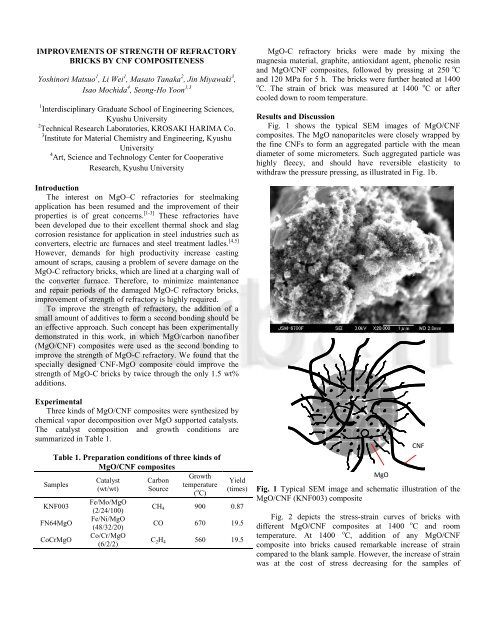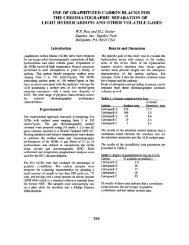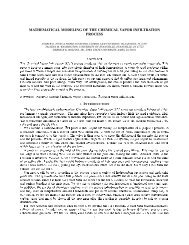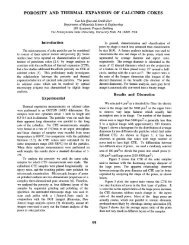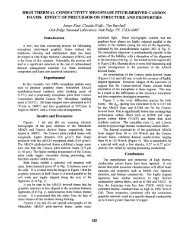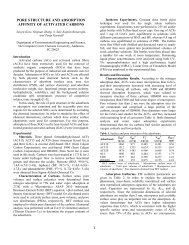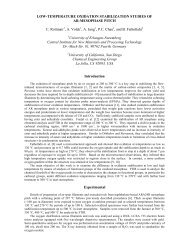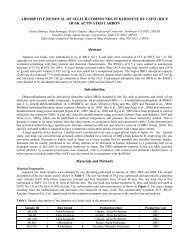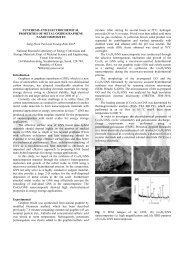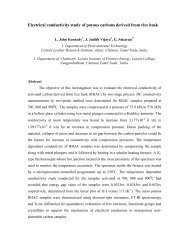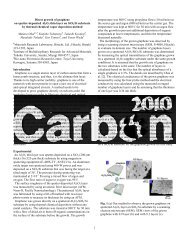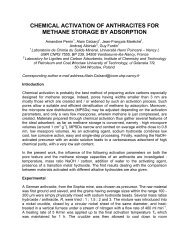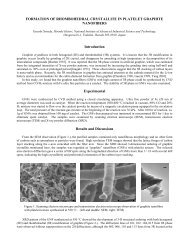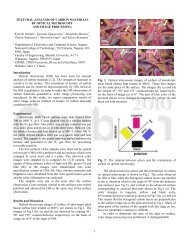improvements of strength of refractory bricks by cnf compositeness
improvements of strength of refractory bricks by cnf compositeness
improvements of strength of refractory bricks by cnf compositeness
Create successful ePaper yourself
Turn your PDF publications into a flip-book with our unique Google optimized e-Paper software.
IMPROVEMENTS OF STRENGTH OF REFRACTORY<br />
BRICKS BY CNF COMPOSITENESS<br />
Yoshinori Matsuo 1 , Li Wei 1 , Masato Tanaka 2 , Jin Miyawaki 3 ,<br />
Isao Mochida 4 , Seong-Ho Yoon 1,3<br />
1 Interdisciplinary Graduate School <strong>of</strong> Engineering Sciences,<br />
Kyushu University<br />
2 Technical Research Laboratories, KROSAKI HARIMA Co.<br />
3 Institute for Material Chemistry and Engineering, Kyushu<br />
University<br />
4 Art, Science and Technology Center for Cooperative<br />
Research, Kyushu University<br />
Introduction<br />
The interest on MgO–C refractories for steelmaking<br />
application has been resumed and the improvement <strong>of</strong> their<br />
properties is <strong>of</strong> great concerns. [1-3] These refractories have<br />
been developed due to their excellent thermal shock and slag<br />
corrosion resistance for application in steel industries such as<br />
converters, electric arc furnaces and steel treatment ladles. [4,5]<br />
However, demands for high productivity increase casting<br />
amount <strong>of</strong> scraps, causing a problem <strong>of</strong> severe damage on the<br />
MgO-C <strong>refractory</strong> <strong>bricks</strong>, which are lined at a charging wall <strong>of</strong><br />
the converter furnace. Therefore, to minimize maintenance<br />
and repair periods <strong>of</strong> the damaged MgO-C <strong>refractory</strong> <strong>bricks</strong>,<br />
improvement <strong>of</strong> <strong>strength</strong> <strong>of</strong> <strong>refractory</strong> is highly required.<br />
To improve the <strong>strength</strong> <strong>of</strong> <strong>refractory</strong>, the addition <strong>of</strong> a<br />
small amount <strong>of</strong> additives to form a second bonding should be<br />
an effective approach. Such concept has been experimentally<br />
demonstrated in this work, in which MgO/carbon nan<strong>of</strong>iber<br />
(MgO/CNF) composites were used as the second bonding to<br />
improve the <strong>strength</strong> <strong>of</strong> MgO-C <strong>refractory</strong>. We found that the<br />
specially designed CNF-MgO composite could improve the<br />
<strong>strength</strong> <strong>of</strong> MgO-C <strong>bricks</strong> <strong>by</strong> twice through the only 1.5 wt%<br />
additions.<br />
Experimental<br />
Three kinds <strong>of</strong> MgO/CNF composites were synthesized <strong>by</strong><br />
chemical vapor decomposition over MgO supported catalysts.<br />
The catalyst composition and growth conditions are<br />
summarized in Table 1.<br />
Table 1. Preparation conditions <strong>of</strong> three kinds <strong>of</strong><br />
MgO/CNF composites<br />
Samples<br />
Catalyst<br />
(wt/wt)<br />
Carbon<br />
Source<br />
Growth<br />
temperature<br />
( o C)<br />
Yield<br />
(times)<br />
KNF003<br />
Fe/Mo/MgO<br />
(2/24/100)<br />
CH4 900 0.87<br />
FN64MgO<br />
Fe/Ni/MgO<br />
(48/32/20)<br />
CO 670 19.5<br />
CoCrMgO<br />
Co/Cr/MgO<br />
(6/2/2)<br />
C2H4 560 19.5<br />
MgO-C <strong>refractory</strong> <strong>bricks</strong> were made <strong>by</strong> mixing the<br />
magnesia material, graphite, antioxidant agent, phenolic resin<br />
and MgO/CNF composites, followed <strong>by</strong> pressing at 250 o C<br />
and 120 MPa for 5 h. The <strong>bricks</strong> were further heated at 1400<br />
o C. The strain <strong>of</strong> brick was measured at 1400 o C or after<br />
cooled down to room temperature.<br />
Results and Discussion<br />
Fig. 1 shows the typical SEM images <strong>of</strong> MgO/CNF<br />
composites. The MgO nanoparitcles were closely wrapped <strong>by</strong><br />
the fine CNFs to form an aggregated particle with the mean<br />
diameter <strong>of</strong> some micrometers. Such aggregated particle was<br />
highly fleecy, and should have reversible elasticity to<br />
withdraw the pressure pressing, as illustrated in Fig. 1b.<br />
MgO<br />
CNF<br />
Fig. 1 Typical SEM image and schematic illustration <strong>of</strong> the<br />
MgO/CNF (KNF003) composite<br />
Fig. 2 depicts the stress-strain curves <strong>of</strong> <strong>bricks</strong> with<br />
different MgO/CNF composites at 1400 o C and room<br />
temperature. At 1400 o C, addition <strong>of</strong> any MgO/CNF<br />
composite into <strong>bricks</strong> caused remarkable increase <strong>of</strong> strain<br />
compared to the blank sample. However, the increase <strong>of</strong> strain<br />
was at the cost <strong>of</strong> stress decreasing for the samples <strong>of</strong>
FN64MgO and CoCrMgO. Only the sample with the addition<br />
<strong>of</strong> KNF003 showed a both increase in the strain and stress.<br />
After cooling to room temperature, similar stress-strain<br />
relations with those at 1400 o C were obtained. The brick with<br />
the addition <strong>of</strong> 1.5% KNF003 showed two times increase both<br />
in its stress and strain, while the strain for samples <strong>of</strong><br />
FN64MgO and CoCrMgO increased at the cost <strong>of</strong> significant<br />
decrease <strong>of</strong> stress.<br />
Fig. 2 The stress-strain curves <strong>of</strong> <strong>bricks</strong> with and without<br />
addition <strong>of</strong> MgO/CNF composites at the 1400 o C (a) and room<br />
temperature (b). Contents <strong>of</strong> MgO/CNF in <strong>bricks</strong> were 1.5 %.<br />
Fig. 3 shows the SEM images <strong>of</strong> a brick with the addition<br />
<strong>of</strong> KNF003. We found that the MgO/CNF composites were<br />
distributed in the matrix, and formed voids <strong>of</strong> hundreds<br />
nanometer size between CNFs intertwined with each other.<br />
( a ) ( b )<br />
Fig. 3 SEM images <strong>of</strong> <strong>bricks</strong> with addition <strong>of</strong> 1.5% KNF003<br />
at low (a) and high (b) magnifications.<br />
1<br />
Based on the SEM results, we propose a model to explain<br />
an improvement <strong>of</strong> stress <strong>by</strong> the addition <strong>of</strong> KNF003 as<br />
follows. Without the MgO/CNF addition, a shock induces<br />
crack formations mainly at the matrix instead <strong>of</strong> hard<br />
magnesia aggregate, which progressively advance to deep into<br />
the brick, giving rise to eventual break down. On the other<br />
hand, in case <strong>of</strong> with the MgO/CNF addition, there are the<br />
voids <strong>of</strong> hundreds nanometer size in MgO/CNF. When the<br />
cracks reach to such voids, elastic CNF networks would act as<br />
a shock-absorber to scatter and release the applied stress, and<br />
thus the progress <strong>of</strong> cracks to deep part <strong>of</strong> the brick would be<br />
relieved. The relaxation <strong>of</strong> crack progress could increase the<br />
<strong>strength</strong> <strong>of</strong> the overall MgO-C brick.<br />
From TEM and STM observations, we found that CNFs<br />
are composed <strong>of</strong> two kinds <strong>of</strong> structural units, nano-rod and<br />
nano-plate (data not shown). KNF003 was composed <strong>of</strong> long<br />
nano-rod units, but the structural unit <strong>of</strong> FN64MgO or<br />
CoCrMgO was nano-plate or short nano-plate, respectively.<br />
The long nano-rod structural unit <strong>of</strong> KNF003 is considered to<br />
give fewer amounts <strong>of</strong> defects compared with short nano-rod<br />
or nano-plate unit, thus should be stronger than others.<br />
According to the aforementioned model, the scattering <strong>of</strong> the<br />
applied stress <strong>by</strong> the CNF networks suppresses the progressive<br />
crack developments. Therefore, the CNFs <strong>of</strong> KNF003 with the<br />
high mechanical <strong>strength</strong> could show the high stress as shown<br />
in Fig. 2. For FN64MgO (nano-plate) and CoCrMgO (short<br />
nano-rod), however, CNFs would be broken down upon the<br />
stress application due to an insufficient <strong>strength</strong>, and then the<br />
progress <strong>of</strong> cracks would be accelerated. This may result<br />
decrease <strong>of</strong> the brick <strong>strength</strong>.<br />
Conclusion<br />
MgO/CNF composites were used as an additive to improve<br />
the <strong>strength</strong> <strong>of</strong> MgO-C <strong>refractory</strong> brick. Two times increase<br />
both in stress and strain were achieved when MgO/CNF<br />
having the long nano-rod structural unit was added. A<br />
mechanism <strong>of</strong> the stress improvement <strong>by</strong> the MgO/CNF<br />
addition was proposed based on the microscopic observations<br />
<strong>of</strong> the MgO/CNF mixed brick. The present results would<br />
greatly improve the creep or spalling resistance and operation<br />
life <strong>of</strong> <strong>refractory</strong> brick.<br />
References<br />
[1] Brant PORC, Limm WA, Grocener C A. Development <strong>of</strong> high<br />
erosion and corrosion resistant MgO–C <strong>bricks</strong> for BOF application.<br />
In UNITECR’93 Proceedings, ALAFAR, Sao Paulo, Brazil, 1993, pp.<br />
462–71.<br />
[2] Lubaba NG, Rand B, Brett NH. Microstructure and <strong>strength</strong> <strong>of</strong><br />
MgO–carbon composite <strong>refractory</strong> materials. Trans.Br. Ceram. Soc.,<br />
1989, 89, 47–54.<br />
[3] Hanagiri S, Harada T, Fugihara S. Effects <strong>of</strong> the addition <strong>of</strong><br />
metal and CaB6 to magnesia carbon <strong>bricks</strong> for converters. Taikabutsu<br />
Overseas, 1993, 13, 20–27.<br />
[4] Naruse Y, Fujimoto S, Kamata Y, Abe M. Results <strong>of</strong><br />
investigation <strong>of</strong> mag-carbon <strong>bricks</strong> used in converter. Taikabutsu,<br />
1983, 3(2), 3–7.<br />
[5] Nagai B, Matsumura T, Hosogawa K, Geji M, Magnesia carbon<br />
<strong>bricks</strong> for hot steel ladles. Taikabutsu, 1986, 38(3), 207–209.


